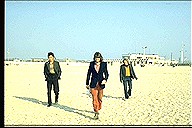| The Stackridge Story |  |
Chapter Three: The Opportunity |
|
Stackridge record with George Martin: In December 1972, the lads threw themselves into a tour with Bristol band 'The Pigsty Hill Light Orchestra', performing a pantomime based on "Treasure Island". Sounds described it as "three hours of fun, lust and lunacy". When a third album was planned, the band received a boost. George Martin’s son had played his father the "Friendliness" album, and his colleagues at Air London Studios had badgered him to work with the band. He agreed. "We were overjoyed," says James. "He was simply the best, and at last we had a producer who was musically incredibly experienced". George worked on the melodic and rhythmic patterns and in particular the vocal harmonies, with the result that whilst all the tracks on "The Man In The Bowler Hat" are full of recognisable Stackridge trademarks, echoes of the Fab Four can nonetheless be heard. September 1973 saw the completion of "The Man In The Bowler Hat", but the band then hit a crisis of confidence. As rock bands go, few worked harder than Stackridge. For four years they had toured the length and breadth of the kingdom, scarcely pausing for breath, let alone taking time out to rest. Despite such efforts, real chart success had so far eluded them. Not surprisingly, the zest began to drain away and the endless grind took its toll. In some quarters, there was a desire for a new direction. Under this strain the tightly-knit group that had functioned so well up to now began to disintegrate. The strange mix of personalities from such varied walks of life that initially gave the band its diversity proved to be a weakness when relationships were put under pressure. Mutter and Billy left. Sadly, the uncertainty meant that the band failed to capitalise on the excellent recording they had just completed under the guidance of George Martin. Instead of giving the album the upbeat promotion it fully deserved, the band leapt off blindly in a different direction with new material. "The Man In The Bowler Hat" finally appeared in February 1974, sporting a bizarre music press advert featuring the ‘new’ line-up, promoting an album by the ‘old’ line-up. The album marked the creative peak for the band and ironically registered its first chart success, but the anomalies of the situation meant that it did not lead on to the greater things it had promised. |
| NEXT EXCITING CHAPTER | PREVIOUS RIVETING CHAPTER | STORY MENU |
This page was updated on October 17th, 2000 by Jennie Evans
Website content: Copyright 2000 Jennie Evans